The NVIDIA GeForce GTX 750 Ti and GTX 750 Review: Maxwell Makes Its Move
by Ryan Smith & Ganesh T S on February 18, 2014 9:00 AM ESTOverclocking: When Headroom Exceeds Clockspeed Limits
Last but not least we have our customary look at overclocking performance. With all 3 of our cards being based on the same reference design, we expect to see some relatively consistent results between the cards. At the same time NVIDIA has told us that GTX 750 has some very interesting overclocking properties, and boy they weren’t kidding.
On a quick note, as a GPU Boost 2.0 product, overclocking on the GTX 750 series is not any different than on other GTX 700 series cards. It’s still based on offset overclocking, with the user adjusting offsets for the final overclock. But with that said there are two things to point out. The first is that the power target is limited to 100% on all cards. Because these are sub-75W cards, NVIDIA is not allowing anyone to exceed the card’s default TDP, so you only have as much power to play with as you started with. Second of all, none of our cards had available overvoltage bins. Apparently some cards do, but ours did not, so our voltage bins maxed out at the default bins you see listed.
Finally, all 3 cards have a maximum clock offset of 135MHz. This will be an important fact in a little bit.
| GeForce GTX 750 Series Overclocking | |||||
| GTX 750 Ti (Ref) | Zotac GTX 750 Ti | Zotac GTX 750 | |||
| Shipping Core Clock | 1020MHz | 1033MHz | 1033MHz | ||
| Shipping Max Boost Clock | 1150MHz | 1175MHz | 1163MHz | ||
| Shipping Memory Clock | 5.4GHz | 5.4GHz | 5.0GHz | ||
| Shipping Max Boost Voltage | 1.168v | 1.137v | 1.187v | ||
| Overclock Core Clock | 1155MHz | 1168MHz | 1168MHz | ||
| Overclock Max Boost Clock | 1285MHz | 1310MHz | 1298MHz | ||
| Overclock Memory Clock | 6.3GHz | 6.1GHz | 6.0GHz | ||
| Overclock Max Boost Voltage | 1.168v | 1.137v | 1.187v | ||
As we can quickly see, two patterns emerge. The first is that with every card equipped with 6GHz memory (though we remain unsure which mode the Zotac GTX 750’s is in), each and every card hits at least 6GHz, and sometimes a bit more. With the 128-bit memory bus generally providing the biggest bottleneck for GM107, the fact that there is 12%+ overclocking headroom here is going to be very helpful in feeding the tiny beast that is GM107.
More significantly however is the core overclock. We maxed out every single one. Every card, from the NVIDIA reference card to the Zotac cards, had no trouble overclocking by the full 135MHz to their respective maximum overclocks. The Zotac GTX 750 Ti, having the highest maximum boost clock by default, is technically the winner here at 1310MHz. But at this point everyone is a winner. Going by the maximum boost clock, every card is capable of an 11% core overclock, to go with that tasty 12% memory overclock.
The fact of the matter is that this is not something we normally encounter. Sub-75W cards are not poor overclockers, but they’re not usually strong overclockers either, which is why a 135MHz offset limit makes sense at first glance. But it’s clear that NVIDIA underestimated their own overclocking potential here when setting the specifications for these cards, as there’s seeming some headroom left untapped. Without additional offset room it’s impossible to say just how much more overclocking headroom remains – it may not be very much – but there should be room for at least some additional overclocking.
At this point with cards already in the pipeline we’ll have to take a look at individual cards and see what manufacturers have set their offset limits at. If they have followed NVIDIA’s specifications, then they’ll be equally limited. But hopefully with the launch now behind them, NVIDIA’s partners can work with NVIDIA on making greater offsets available on newer batches of cards.
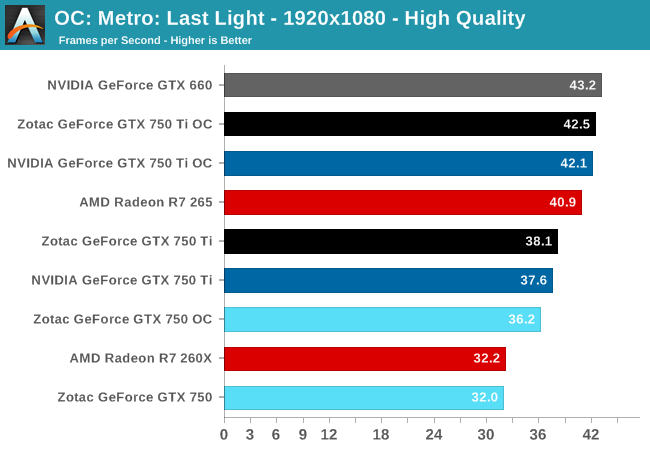
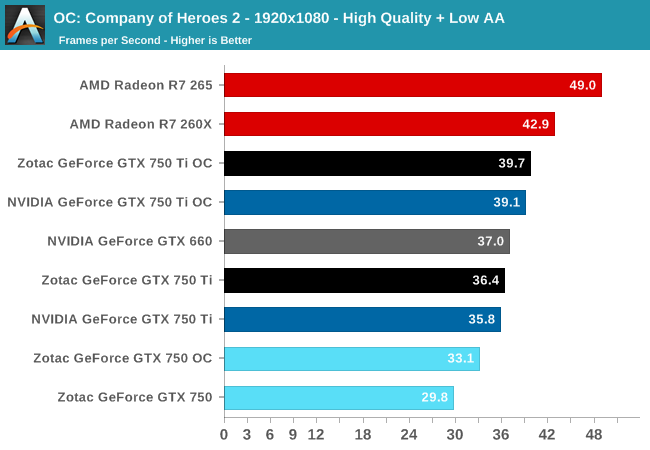
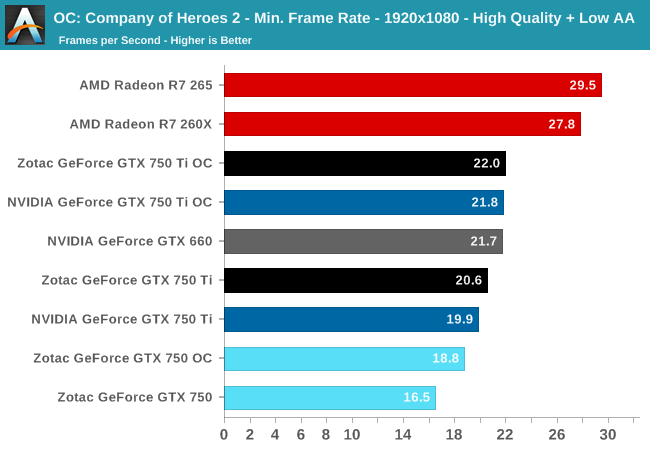

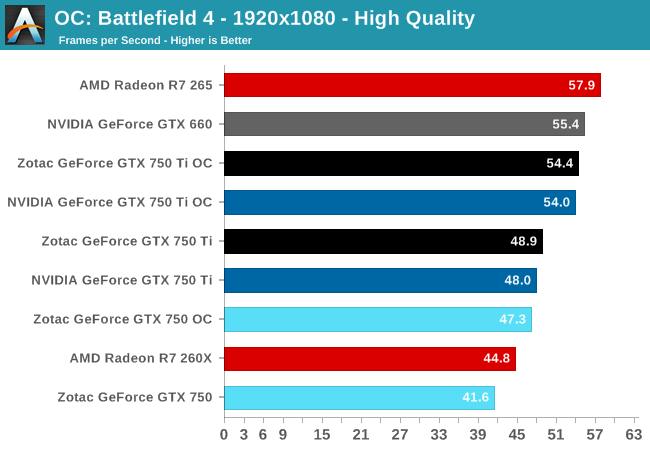
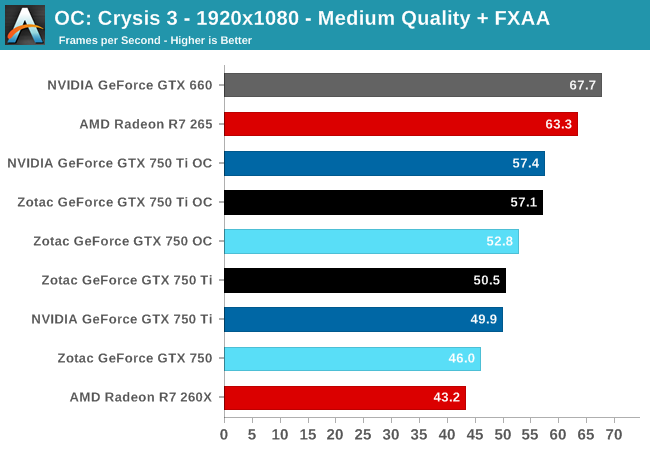
Depending on the game being used, the benefits from overclocking range from 9% to 12%, roughly in-line with our overclocks. For the GTX 750 this is sometimes enough to catch the stock clocked R7 260X, but even with this overclock the GTX 750 Ti will still generally trail the R7 265.
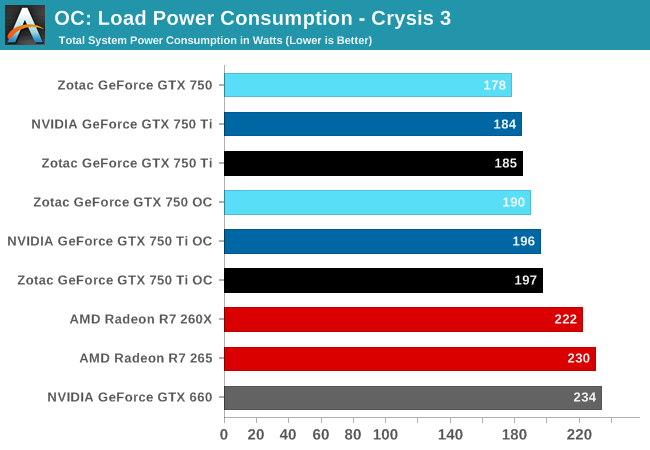

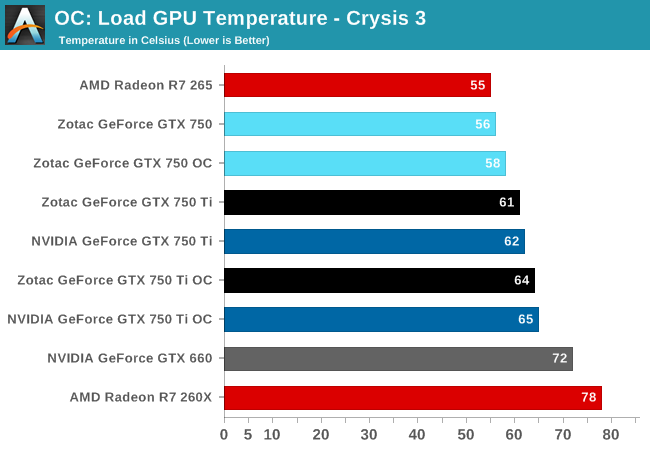
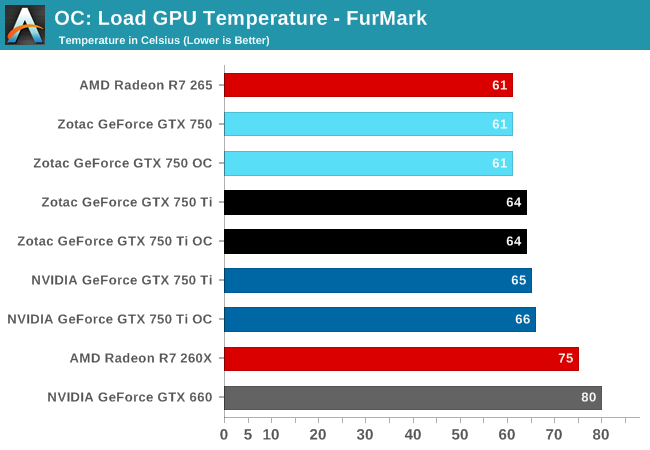
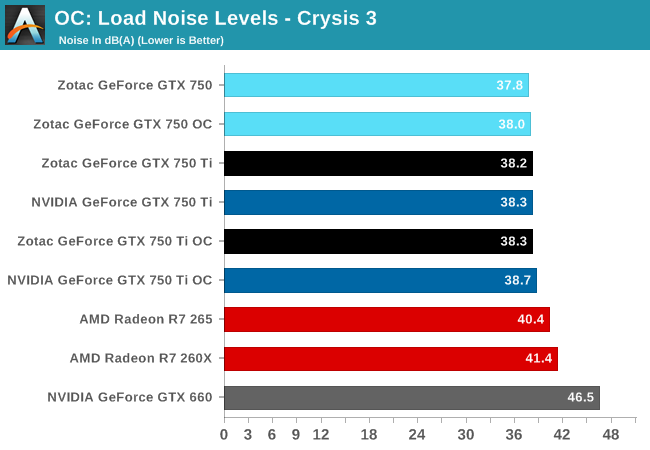
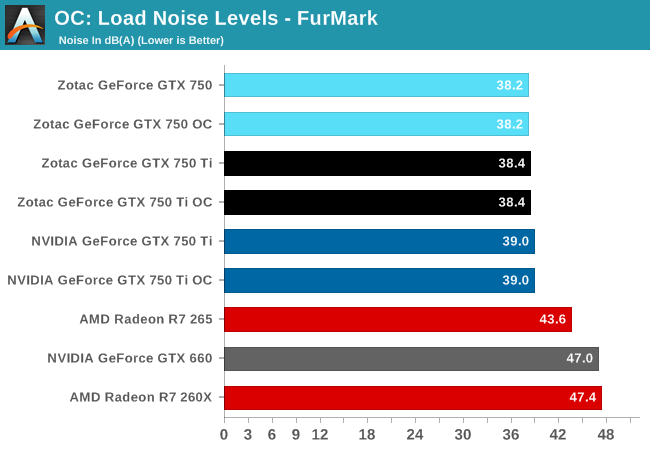
On the other hand, because of the hard TDP limit of 100%, this extra performance is relatively cheap. Video card power consumption moves by only a few watts, and then a few watts of CPU time on top of that. For all practical purposes overclocking can extend NVIDIA’s already incredible performance-per-watt ratio by another 10% with no meaningful impact on noise. Given the consistency of overclocking headroom we’ve seen in our GTX 750 series samples, this is one of those scenarios where overclocking is going to be a reasonable and (relatively) fool proof action to take.










177 Comments
View All Comments
formulav8 - Tuesday, February 18, 2014 - link
Overall their drivers have been fine for a long time. NVidia and AMD run into bugs time to time. I'm sure you know NVidia has bugs as well. Just because you don't see them doesn't mean there are none and that NVidia is perfect.dgingeri - Wednesday, February 19, 2014 - link
yeah, well, I've never had bugs with my Nvidia cards to the degree of the bugs with my two AMD/ATI video cards. I had that 4870X2 for over a year and a half, quietly waiting for them to fix the bugs in the drivers to get it to properly use the second GPU, only to have them completely abandon me at the 10.1 driver and beyond.extide - Tuesday, February 18, 2014 - link
So, really, not even a single mention of Maxwell's marquee feature, "Unified Virtual Memory?" I think you guys got a little bit caught up in the power/watt increase, and entirely forgot about that!kwrzesien - Tuesday, February 18, 2014 - link
It will probably be unveiled with the 800 series cards. It might be baked into the die but not enabled in this revision or it might be there but not enabled in the drivers. What we want to wait for is the 860/880 which will have the muscle to do something amazing with UVM.jwcalla - Tuesday, February 18, 2014 - link
I don't think UVM will provide much in the way of benefits other than making some CUDA programming [marginally] easier.doubledeej - Tuesday, February 18, 2014 - link
Is anybody ever going to produce a decent single slot video card again? I'm getting a little tired of either having low-end, slow cards, or having all of my PCIe slots being covered up.DanNeely - Tuesday, February 18, 2014 - link
Probably not. Making a quiet card is much easier in a 2 slot form factor; and the number of people who care about performance and need the slot immediately below their GPU is a very small fraction of the total.On a tangent, legacy PCI is facing extinction because it's been removed from Intel's current chipsets and is only available via a bridge chip. If you have a long term need for it; I'd advise buying a current generation mobo with an unobstructed slot while they're still on the market.
TheinsanegamerN - Tuesday, February 18, 2014 - link
you mean like the geforce 680 single slot edition that never came out? yeah, I wish companies would actually make those things.FelixDraconis - Tuesday, February 18, 2014 - link
I really like the direction this card is going in. Especially if there's a DisplayPort variant coming. It's tough building a low power ITX system with DP without using onboard graphics.But what's up with the 750 name? That's just blatantly misleading, as the 760 has been out for almost a year now and is an older process, while originally Maxwell was slated to be called 8XX. Nothing new, but boy is this confusing. I guess it makes short term sense for marketing, as it always does.
jwcalla - Tuesday, February 18, 2014 - link
Obviously they're reserving the 800 series for the 20nm parts.